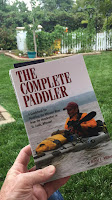The countdown to the May 15th put-in continues! This week I'm working on itinerary and thinking about the details of traveling to Montana. I've loaded the boat on the truck a few times and she seems to ride nicely but I did need to purchase some new anchors for the hood/front tie down straps. I guess it never hurts to work out those kinds of loose ends before the actual day of departure.
This week's blog update is a short one as all the major packing and planning is done. I thought it might be a good time to talk about boat registration and decals. Nebraska law doesn't require registering a canoe and the same is true for the states of Montana and North Dakota. Unfortunately, South Dakota regulations state, in part, that "non-motorized boats over 12 feet in length must have a validation sticker, but boat numbering is optional." A bit confusing, especially for a river through-padder.
My take when reading the regulation was that if I didn't want to worry about being hassled I should register my canoe. Of course, doing so turns out to be harder than you'd think. After locating the proper form on the Nebraska DMV website, I made my way over to the nearest office. I was told by the clerk that I wasn't required to register my canoe and she was a bit surprised at my response of "yes, but I want to." Evidently, there are few idiots that insist on filling out paperwork, standing in line for over an hour, and spending $27 when they aren't required to do so. After three supervisors were called for assistance and I was questioned several times about why, I left with my pink registration form in hand (yeah me!).The next step in this odyssey was to locate stick-on decals. Google being the friend that it is, a quick online search yielded a couple of companies with online tools for designing and ordering the correct setup.
While ordering my registration decals I decided it would be good to throw in an order for my boat's name. One of my blog posts from my trip down the lower Missouri ten years ago highlighted my decision to name her the "James Caird." I have long been intrigued with the 1916 Ernest Shackleton led open boat rescue voyage from Elephant Island to St. George Island (800 miles across the roughest waters on the planet!). Since my boat is about the same length as that craft and will be occasionally under sail, I figure I'm justified in giving her an official name. After all, I will be living in her for about 8 straight weeks and she's more than a weekend sit on top canoe.

















